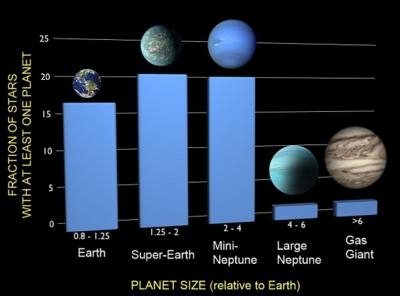Mon, Jan 14, 2013
Milky Way Galaxy May Contain 17 Billion Planets Of Similar Size
The quest to determine if planets like Earth are rare or common is taking another stride forward. Using NASA's Kepler spacecraft, managed by NASA Ames Research Center, astronomers are beginning to find Earth-sized planets orbiting distant stars. A new analysis of Kepler data shows that about 17 percent of stars have an Earth-sized planet in an orbit closer than Mercury. Since the Milky Way has about 100 billion stars, there are at least 17 billion Earth-sized worlds out there.

Francois Fressin, of the Harvard-Smithsonian Center for Astrophysics (CfA), presented the analysis today in a press conference at a meeting of the American Astronomical Society in Long Beach, CA. A paper detailing the research has been accepted for publication in The Astrophysical Journal. The research team found that 50 percent of all stars have a planet of Earth-size or larger in a close orbit. By adding larger planets detected in wider orbits up to the orbital distance of the Earth, this number increases to 70 percent.
Extrapolating from Kepler's currently ongoing observations and results from other detection techniques, scientists have determined that nearly all sun-like stars have planets. Planets closer to their stars are easier to find because they transit more frequently. As more data are gathered, planets in larger orbits will be detected. In particular, Kepler's extended mission will enable the detection of Earth-sized planets at greater distances, including Earth-like orbits in the "habitable zone," the region in a planetary system where liquid water might exist on the surface of an orbiting planet.
Kepler is the first NASA mission capable of finding Earth-size planets orbiting in or near the habitable zone of the host star. NASA's Ames Research Center, Moffett Field, CA, is the home organization of the science principal investigator, and is responsible for the ground system development, mission operations, and science data analysis.
(Image provided by NASA)
More News
From 2023 (YouTube Version): Legacy of a Titan Robert (Bob) Anderson Hoover was a fighter pilot, test pilot, flight instructor, and air show superstar. More so, Bob Hoover was an i>[...]
Get The Latest in Aviation News NOW on Instagram Are you on Instagram yet? It's been around for a few years, quietly picking up traction mostly thanks to everybody's new obsession >[...]
Aero Linx: B-52H Stratofortress The B-52H Stratofortress is a long-range, heavy bomber that can perform a variety of missions. The bomber is capable of flying at high subsonic spee>[...]
Altimeter Setting The barometric pressure reading used to adjust a pressure altimeter for variations in existing atmospheric pressure or to the standard altimeter setting (29.92).>[...]
"Knowing that we play an active part in bettering people's lives is extremely rewarding. My team and I are very thankful for the opportunity to be here and to help in any way we ca>[...]
 Classic Aero-TV: Remembering Bob Hoover
Classic Aero-TV: Remembering Bob Hoover ANN FAQ: Follow Us On Instagram!
ANN FAQ: Follow Us On Instagram! ANN's Daily Aero-Linx (05.15.24)
ANN's Daily Aero-Linx (05.15.24) ANN's Daily Aero-Term (05.15.24):Altimeter Setting
ANN's Daily Aero-Term (05.15.24):Altimeter Setting Aero-News: Quote of the Day (05.16.24)
Aero-News: Quote of the Day (05.16.24)



